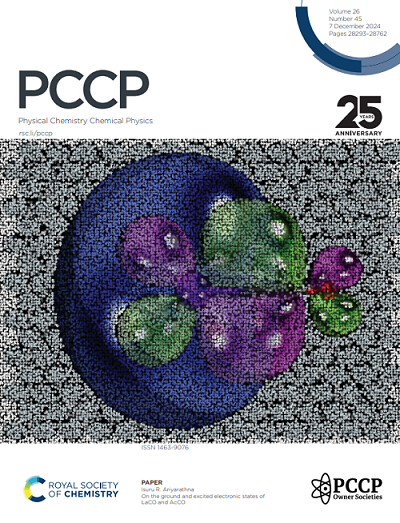Impact of Nitrogen Configuration on the Electronic Properties of Tailored Triphenilamine Derivatives as Hole Transport Materials for Perovskite Solar Cells: A Computational Chemistry Study
IF 2.9
3区 化学
Q3 CHEMISTRY, PHYSICAL
引用次数: 0
Abstract
Physical properties associated with charge transfer processes of tailored triphenylamine derivative molecules, generated from six nitrogen-containing heterocyclic aromatic cores (nTPAM), were theoretically studied. The conformer-rotamer ensemble sampling tool (CREST) was employed to study the geometric arrangements of n-TPAM monomers and dimers. Essential chemical parameters, such as reorganisation energies, spin densities, and chemical reactivity, were computed utilising the M06, 𝜔B97X, and 𝜔B97X-3c DFT functionals. The 𝜔 parameter of the 𝜔B97X-3c functional was optimised through a non-empirical tuning method. Time-dependent DFT (TD-DFT-M06/6-31G(d,p)) computations yielded insights into the maximum absorption wavelength and transition density matrix of n-TPAM monomers. The electronic coupling between dimers was assessed using M06 and 𝜔B97X. The HOMO energy levels of the n-TPAM derivatives correspond with the perovskite conduction band, situated between YZ22 and SpiroOMeTAD hole transport materials (HTM). n-TPAM molecules demonstrated enhanced electronic coupling for hole transfer, except for C-TPAM (Jeff(h) = 52.3 meV), in contrast to YZ22 (Jeff(h) = 79.5 meV). Nonetheless, n-TPAM exhibited elevated reorganisation energies, varying from 291 to 346 meV, compared to YZ22 (150 meV). Among the analysed derivatives, A-TPAM exhibited the highest chemical hardness and was the only molecule with absorption extending beyond the visible spectrum, as forecasted by TD-DFT. Although A-TPAM exhibited superior electronic properties, its high reorganisation energy may limit its performance as HTM compared to YZ22. Our analysis revealed that the electronic properties relevant to the hole extraction process can be tuned by modifying the nitrogen core configuration. Additionally, the degree of charge delocalisation in cationic compounds significantly influences charge transfer rates; therefore, an optimised DFT functional that effectively represents charge delocalisation is crucial for anticipating accurate trends in physical characteristics.求助全文
约1分钟内获得全文
求助全文
来源期刊

Physical Chemistry Chemical Physics
化学-物理:原子、分子和化学物理
CiteScore
5.50
自引率
9.10%
发文量
2675
审稿时长
2.0 months
期刊介绍:
Physical Chemistry Chemical Physics (PCCP) is an international journal co-owned by 19 physical chemistry and physics societies from around the world. This journal publishes original, cutting-edge research in physical chemistry, chemical physics and biophysical chemistry. To be suitable for publication in PCCP, articles must include significant innovation and/or insight into physical chemistry; this is the most important criterion that reviewers and Editors will judge against when evaluating submissions.
The journal has a broad scope and welcomes contributions spanning experiment, theory, computation and data science. Topical coverage includes spectroscopy, dynamics, kinetics, statistical mechanics, thermodynamics, electrochemistry, catalysis, surface science, quantum mechanics, quantum computing and machine learning. Interdisciplinary research areas such as polymers and soft matter, materials, nanoscience, energy, surfaces/interfaces, and biophysical chemistry are welcomed if they demonstrate significant innovation and/or insight into physical chemistry. Joined experimental/theoretical studies are particularly appreciated when complementary and based on up-to-date approaches.
 求助内容:
求助内容: 应助结果提醒方式:
应助结果提醒方式:


